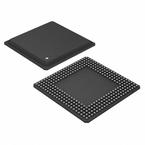Part Datasheet Search > Digital Signal Processors(DSPs) > TI > TMS320C6418ZTSA500 Datasheet PDF
TMS320C6418ZTSA500 Datasheet PDF - TI
| Manufacturer: | TI |
| Category: | Digital Signal Processors(DSPs) |
| Case Package: | 288-BBGA, FCBGA |
| Description: | DSP Fixed-Point 32Bit 500MHz 4000MIPS 288Pin FCBGA |
| Documentation: | TMS320C6418ZTSA500 Datasheet TMS320C6418ZTSA500 User Reference Manual Guide (145 Pages) |
| Pictures: |
TMS320C6418ZTSA500 Datasheet PDF
ADatasheet has not yet included the datasheet for TMS320C6418ZTSA500
If necessary, please send a supplementary document request to the administrator

TMS320C6418ZTSA500 Specifications
| TYPE | DESCRIPTION |
|---|---|
| Mounting Style | Surface Mount |
| Frequency | 500 MHz |
| Number of Pins | 288 Pin |
| Supply Voltage (DC) | 1.14 V (min) |
| Case/Package | 288-BBGA, FCBGA |
| Clock Speed | 500 MHz |
| Number of Bits | 0 Bit |
TMS320C6418ZTSA500 Size & Package
| TYPE | DESCRIPTION |
|---|---|
| Product Lifecycle Status | Active |
TMS320C6418ZTSA500 Environmental
TMS320C6418ZTSA500 Function Overview
The TMS320C64x DSPs (including the TMS320C6418 device) are the highest-performance fixed-point DSP generation in the TMS320C6000 DSP platform. The TMS320C6418 (C6418) device is based on the second-generation high-performance, advanced VelociTI very-long-instruction-word (VLIW) architecture (VelociTI.2) developed by Texas Instruments (TI). The high-performance, lower-cost C6418 DSP enables customers to reduce system costs for telecom, software radio, Digital Terrestrial Television Broadcasting (DTTB), and digital Broadcast Satellite/Communication Satellite (BS/CS) applications. The C64x is a code-compatible member of the C6000 DSP platform.
●With performance of up to 4800 million instructions per second (MIPS) at a clock rate of 600 MHz, the C6418 device offers cost-effective solutions to high-performance DSP programming challenges. The C6418 DSP possesses the operational flexibility of high-speed controllers and the numerical capability of array processors. The C64x. DSP core processor has 64 general-purpose registers of 32-bit word length and eight highly independent functional unitstwo multipliers for a 32-bit result and six arithmetic logic units (ALUs)with VelociTI.2 extensions. The VelociTI.2 extensions in the eight functional units include new instructions to accelerate the performance in video and imaging applications and extend the parallelism of the VelociTI architecture. The C6418 can produce four 16-bit multiply-accumulates (MACs) per cycle for a total of 2400 million MACs per second (MMACS), or eight 8-bit MACs per cycle for a total of 4800 MMACS. The C6418 DSP also has application-specific hardware logic, on-chip memory, and additional on-chip peripherals similar to the other C6000 DSP platform devices.
●The C6418 device has a high-performance embedded coprocessor [Viterbi Decoder Coprocessor (VCP)] that significantly speed up channel-decoding operations on-chip. The VCP operating at CPU clock divided-by-4 can decode over 500 7.95-Kbps adaptive multi-rate (AMR) [K = 9, R = 1/3] voice channels. The VCP supports constraint lengths K = 5, 6, 7, 8, and 9, rates R = 1/2, 1/3, and 1/4, and flexible polynomials, while generating hard decisions or soft decisions. Communications between the VCP and the CPU are carried out through the EDMA controller.
●The C6418 uses a two-level cache-based architecture and has a powerful and diverse set of peripherals. The Level 1 program cache (L1P) is a 128-Kbit direct mapped cache and the Level 1 data cache (L1D) is a 128-Kbit 2-way set-associative cache. The Level 2 memory/cache (L2) consists of an 4-Mbit memory space that is shared between program and data space. L2 memory can be configured as mapped memory, cache (up to 256K bytes), or combinations of the two. The peripheral set includes: two multichannel buffered audio serial ports (McASPs); two inter-integrated circuit bus modules (I2Cs) ; two multichannel buffered serial ports (McBSPs); three 32-bit general-purpose timers; a user-configurable 16-bit or 32-bit host-port interface (HPI16/HPI32); a 16-pin general-purpose input/output port (GP0) with programmable interrupt/event generation modes; and a 32-bit glueless external memory interface (EMIFA), which is capable of interfacing to synchronous and asynchronous memories and peripherals.
●Each McASP port supports one transmit and one receive clock zone, with six serial data pins which can be individually allocated to any of the two zones. The serial port supports time-division multiplexing on each pin from 2 to 32 time slots. The C6418 has sufficient bandwidth to support all six serial data pins transmitting a 192-kHz stereo signal. Serial data in each zone may be transmitted and received on multiple serial data pins simultaneously and formatted in a multitude of variations on the Philips Inter-IC Sound (I2S) format.
●In addition, the McASP transmitter may be programmed to output multiple S/PDIF, IEC60958, AES-3, CP-430 encoded data channels simultaneously, with a single RAM containing the full implementation of user data and channel status fields.
●McASP also provides extensive error-checking and recovery features, such as the bad clock detection circuit for each high-frequency master clock which verifies that the master clock is within a programmed frequency range.
●The I2C ports on the TMS320C6418 allows the DSP to easily control peripheral devices and communicate with a host processor. In addition, the standard multichannel buffered serial port (McBSP) may be used to communicate with serial peripheral interface (SPI) mode peripheral devices.
●The C6418 has a complete set of development tools which includes: a new C compiler, an assembly optimizer to simplify programming and scheduling, and a Windows debugger interface for visibility into source code execution.
show more
TMS320C6418ZTSA500 Documents
TMS320C6418 Documents
Part Datasheet PDF Search
Example: STM32F103
72,405,303 Parts Datasheet PDF, Update more than 5,000 PDF files ervery day.

